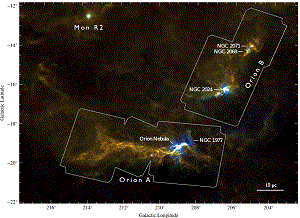Herschel-Planck optical-depth maps. I. Orion (Lombardi et al.)
- Details
- Published on 03 June 2014
Vol. 566
In section 6. Interstellar and circumstellar matter
Herschel-Planck dust optical-depth and column-density maps. I. Method description and results for Orion
 Our understanding of the star formation rate in galaxies other than our own is based on various forms of the Schmidt law, which relates the star formation rate to gas mass. The Schmidt law is empirical and is typically valid on size scales of a few hundred parsecs or more. It clearly would be interesting to establish the validity of this type of relationship in the Milky Way, with the ultimate aim of deriving the physical basis of the Milky Way. This requires studying the density or column density distribution in Milky Way clouds where young stars are forming. The study of the Orion complex by Lombardi et al. does this by combining dust emission maps from Herschel, and Planck with dust extinction maps based on the 2MASS survey. The result is a map covering more than 2 orders of magnitude in column density (from a K extinction of 0.05 mag to 10 mag.), which shows that the local protostar column density varies with approximately the square of the gas column.
Our understanding of the star formation rate in galaxies other than our own is based on various forms of the Schmidt law, which relates the star formation rate to gas mass. The Schmidt law is empirical and is typically valid on size scales of a few hundred parsecs or more. It clearly would be interesting to establish the validity of this type of relationship in the Milky Way, with the ultimate aim of deriving the physical basis of the Milky Way. This requires studying the density or column density distribution in Milky Way clouds where young stars are forming. The study of the Orion complex by Lombardi et al. does this by combining dust emission maps from Herschel, and Planck with dust extinction maps based on the 2MASS survey. The result is a map covering more than 2 orders of magnitude in column density (from a K extinction of 0.05 mag to 10 mag.), which shows that the local protostar column density varies with approximately the square of the gas column.

